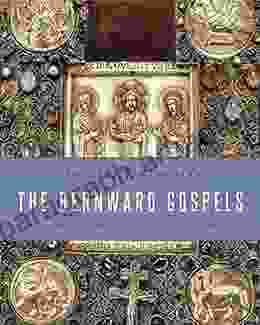Art Memory And The Episcopate In Medieval Germany

In the heart of medieval Germany, where faith and power intertwined, art played a pivotal role in shaping the memory and identity of the episcopate. From towering cathedrals to illuminated manuscripts and precious relics, visual culture served as a powerful medium for preserving historical narratives, celebrating religious figures, and transmitting sacred knowledge. This article explores the intricate relationship between art, memory, and the episcopate, shedding light on the profound impact of images in shaping the spiritual and political landscape of medieval Germany.
5 out of 5
| Language | : | English |
| File size | : | 65708 KB |
| Text-to-Speech | : | Enabled |
| Screen Reader | : | Supported |
| Enhanced typesetting | : | Enabled |
| Print length | : | 479 pages |
Cathedrals: Monolithic Symbols of Episcopal Authority
Cathedrals were the most visible and enduring expressions of episcopal power in medieval Germany. These magnificent structures, with their soaring spires and intricate facades, served as both architectural marvels and centers of religious life. Through their grandeur and ornamentation, cathedrals projected the authority and prestige of the bishops who commissioned them. The architectural details, sculptures, and stained-glass windows of these sacred spaces narrated biblical stories, depicted the lives of saints, and celebrated the achievements of the local episcopacy.
A striking example is the Cologne Cathedral, a UNESCO World Heritage Site and one of the largest Gothic churches in the world. Its construction, spanning over six centuries, reflects the enduring legacy of the Archbishops of Cologne. The cathedral's magnificent choir, with its intricate carvings and stained-glass windows, portrays scenes from the life of Christ, emphasizing the archbishop's role as a shepherd of his flock. The Three Kings Reliquary, enshrined within the cathedral, further enhanced the archbishop's authority by associating him with the Magi, biblical figures who recognized the divine nature of Christ.
Illuminated Manuscripts: Preserving Episcopal Legacies
Beyond the grand scale of cathedrals, illuminated manuscripts provided a more intimate and portable means of preserving episcopal memory. These exquisite works of art, commissioned by bishops and other high-ranking clergy, served as both liturgical aids and historical records. The miniatures, initials, and bFree Downloads of these manuscripts depicted the lives of saints, religious ceremonies, and the deeds of the sponsoring bishops. They were often used in liturgical rituals, reinforcing the authority of the episcopate and connecting them to the sacred past.
The Codex Aureus Epternacensis, a ninth-century illuminated manuscript, showcases the intricate relationship between art and episcopal memory. It contains a detailed narrative of the life of Saint Willibrord, the first bishop of Utrecht, emphasizing his role in spreading Christianity in northern Europe. The manuscript's lavish illuminations serve as a visual testament to Willibrord's legacy and the enduring power of the episcopate in shaping religious identity.
Relics: Tangible Connections to the Sacred
In medieval Germany, relics, physical remains or objects associated with saints or religious figures, played a central role in the cult of the saints and the veneration of the episcopate. Bishops were often instrumental in acquiring and preserving these sacred treasures, which attracted pilgrims from far and wide. The possession of relics enhanced the prestige of the bishop and his diocese, as they were believed to possess miraculous powers and provide a direct connection to the divine.
One of the most renowned relic collections in medieval Germany was housed at the Aachen Cathedral. The Palatine Chapel, built by Charlemagne in the eighth century, became a pilgrimage destination due to its possession of the relics of the Virgin Mary, Saint Stephen, and other holy figures. The presence of these relics strengthened the authority of the Archbishops of Cologne and established Aachen as a prominent center of pilgrimage and spirituality.
Memory and Historiography
The art and material culture produced under the patronage of the episcopate in medieval Germany not only shaped contemporary perceptions but also influenced the writing of history. Chronicles, annals, and other historical accounts relied heavily on visual sources, such as cathedral carvings, illuminated manuscripts, and relics, to construct narratives about the past. These images provided a visual framework for understanding history, reinforcing the role of the episcopate in shaping religious and political events.
The "Gesta Treverorum," a twelfth-century chronicle commissioned by the Archbishop of Trier, is a prime example of how art informed historical writing. The manuscript contains numerous illustrations depicting the lives of Trier's bishops and the history of the diocese. These images served as a visual counterpart to the written text, enhancing the credibility and authority of the chronicle by grounding it in tangible visual evidence.
Cultural Heritage and Contemporary Significance
The artistic legacy of the medieval German episcopate is not merely a matter of historical interest but continues to shape cultural heritage and inspire contemporary artistic expression. Many cathedrals, manuscripts, and relics from this period remain intact, providing a tangible connection to the past and serving as symbols of religious and cultural continuity. They continue to attract visitors from around the world, fostering appreciation for the artistic achievements and spiritual significance of medieval Germany.
Furthermore, contemporary artists and scholars draw inspiration from the art and memory of the medieval episcopate. The exploration of religious themes, the use of traditional techniques, and the reinterpretation of historical narratives are evident in various artistic practices today. By engaging with this rich artistic heritage, modern creators contribute to the ongoing dialogue between past and present, ensuring that the memory and impact of the episcopate in medieval Germany continue to resonate in contemporary culture.
The art produced under the patronage of the episcopate in medieval Germany played a vital role in shaping memory, preserving historical narratives, and reinforcing religious and political authority. From towering cathedrals to exquisite manuscripts and sacred relics, visual culture served as a powerful medium for transmitting knowledge, inspiring devotion, and constructing a sense of identity. By exploring the intricate relationship between art, memory, and the episcopate, we gain a deeper understanding of the spiritual, cultural, and historical forces that shaped medieval Germany and continue to influence us today.
5 out of 5
| Language | : | English |
| File size | : | 65708 KB |
| Text-to-Speech | : | Enabled |
| Screen Reader | : | Supported |
| Enhanced typesetting | : | Enabled |
| Print length | : | 479 pages |
Do you want to contribute by writing guest posts on this blog?
Please contact us and send us a resume of previous articles that you have written.
 Book
Book Novel
Novel Page
Page Chapter
Chapter Text
Text Story
Story Genre
Genre Reader
Reader Library
Library Paperback
Paperback E-book
E-book Magazine
Magazine Newspaper
Newspaper Paragraph
Paragraph Sentence
Sentence Bookmark
Bookmark Shelf
Shelf Glossary
Glossary Bibliography
Bibliography Foreword
Foreword Preface
Preface Synopsis
Synopsis Annotation
Annotation Footnote
Footnote Manuscript
Manuscript Scroll
Scroll Codex
Codex Tome
Tome Bestseller
Bestseller Classics
Classics Library card
Library card Narrative
Narrative Biography
Biography Autobiography
Autobiography Memoir
Memoir Reference
Reference Encyclopedia
Encyclopedia John H Lau
John H Lau Joan Cangiarella
Joan Cangiarella John L Lamattina
John L Lamattina Jere Van Dyk
Jere Van Dyk Jim Robbins
Jim Robbins Mark A Robinson
Mark A Robinson Jessie Czebotar
Jessie Czebotar Jeremy Camp
Jeremy Camp Terri Gordon Zolov
Terri Gordon Zolov Joe Delaronde
Joe Delaronde Monica Huerta
Monica Huerta Monica T Whitty
Monica T Whitty Jennifer S Holland
Jennifer S Holland Nurse Mierda
Nurse Mierda Jess Oppenheimer
Jess Oppenheimer John Lennon
John Lennon Joe Ryder
Joe Ryder Linda Stradling
Linda Stradling Randy Borum
Randy Borum Joel Thielke
Joel Thielke
Light bulbAdvertise smarter! Our strategic ad space ensures maximum exposure. Reserve your spot today!

 Grayson BellMy Portuguese Words Picture With English Translation Bilingual English: The...
Grayson BellMy Portuguese Words Picture With English Translation Bilingual English: The...
 Eliot FosterUnleash Your Potential: Discover Amazing 151 Motivational Short Stories That...
Eliot FosterUnleash Your Potential: Discover Amazing 151 Motivational Short Stories That... Tom HayesFollow ·11.9k
Tom HayesFollow ·11.9k Jeremy CookFollow ·16k
Jeremy CookFollow ·16k Stanley BellFollow ·11.6k
Stanley BellFollow ·11.6k Gavin MitchellFollow ·12k
Gavin MitchellFollow ·12k Joseph HellerFollow ·8k
Joseph HellerFollow ·8k Gordon CoxFollow ·2.8k
Gordon CoxFollow ·2.8k Dallas TurnerFollow ·4.1k
Dallas TurnerFollow ·4.1k Gabriel MistralFollow ·6.9k
Gabriel MistralFollow ·6.9k

 Julio Cortázar
Julio CortázarAn Illustrated Encyclopedia Of Live Concerts And...
Immerse yourself in the...

 Edgar Cox
Edgar CoxNon Physically Assaultive Attachment Based Chronic Covert...
What is Covert...

 Robert Reed
Robert ReedThe Baseball of Why: Unraveling the Intricacies of...
Step up to the plate and...

 Aldous Huxley
Aldous HuxleyTacos and Beer: An Atmosphere of Flavorful Delights
In the realm of culinary adventures,...

 Stan Ward
Stan WardUnlock the Secrets of the Aramaic Jesus: Revelations of a...
Journey Back to the Roots of...

 Vincent Mitchell
Vincent MitchellMillionaire Success Strategies: Your Blueprint for...
Unlock the...
5 out of 5
| Language | : | English |
| File size | : | 65708 KB |
| Text-to-Speech | : | Enabled |
| Screen Reader | : | Supported |
| Enhanced typesetting | : | Enabled |
| Print length | : | 479 pages |








